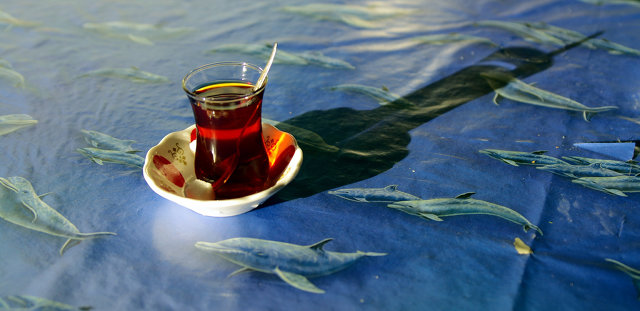Last year, I asked famed designer Marc Newson what he and his BFF Jony Ive talked about when they grabbed a couple of pints. I remember being extremely disappointed with his answer. He said that when he and Ive got a beer together, they spent most of their time talking about the glass it was served in.
I was new to writing about design at the time, so my first response was to roll my eyes and make a rude flapping gesture with my hand. It seemed boring and pedantic and precious. But over the past month, on my honeymoon in Turkey, I've spent a lot of time thinking about Newson's answer. Like Ive and Newson, I've recently found myself captivated by the design of a glass: in my case, the small, tulip-shaped glasses in which the Turks serve tea. And I think I now understand what Newson was talking about.
Clik here to view.

In Turkey, tea is shared in the same way as a handshake in the United States; when you meet someone, whether for the thousandth time or a first time, you have a glass together. Tea in Turkey isn't just a drink. It's a ritual deeply ingrained into the fabric of day-to-day social life. Because of this, the way tea is brewed in Turkey is very different from the way it is done in the United States.
For one thing, there's not a teabag to be seen. Rather, tea is made in a stacked, double-decker metal teapot called a çaydanlık. The larger kettle on the bottom is used to boil water. As the steam escapes from this kettle, it brews a smaller kettle full of strong tea that serves as its lid. Unlike a traditional teakettle, the idea with a çaydanlık is to keep it over a low flame on the stovetop once the water has been boiled and tea has been brewed. This is because tea in Turkey is not just a one-cup affair. It is served constantly throughout the day.
Clik here to view.

Because of this, the design of the kettle had to change to keep up. While in America, a kettle is something to be snatched off the burner the moment it releases its siren shriek, in Turkey, it is kept simmering: a liquid hearth around which friends, guests, and random passersby can perpetually warm themselves and caffeinate. By keeping brewed tea and a larger kettle full of water simmering but separate, tea is never overbrewed, no matter how long it seeps. Instead, undiluted tea is kept at a consistent brew strength, called tavşan kanı. It means "rabbit's blood" and it describes the ideal color of the undiluted brew--just add water.
From a design perspective, it's hard not to admire the Turkish teakettle. Distilled to the essence of its function, the çaydanlık solves many problems at once. Tea can be kept hot for hours at a time, without ever becoming overbrewed. Each drinker can have a cup of tea that is exactly as strong or weak as he or she wants it. And because the çaydanlık has two separate kettles, each can be topped up separately, guaranteeing that the trickle of tea continues unabated throughout the course of the day.
Clik here to view.

And then there's the cup. Traditionally, Turkish tea is served in a small tulip-shaped glass called a fincan çay. It's not intuitive: boiling liquid and glass generally doesn't mix. But the transparency of the glass makes it easy to see how strong or weak the tea is, while the narrow waist offers a visual guide for the right proportion of water to rabbit's blood. Meanwhile, the flared petals of the tulip allow the hot glass to be picked up safely.
To drink Turkish tea is to see how culture and design collide. In Turkey, it is possible to both compliment and insult some in Turkey just by serving him or her a cup of tea that is either too strong or too weak. And while almost excessive hospitality is a point of pride in Turkish culture, the diminutive size of the tea glasses gives hosts and guests alike an easy out if things are getting tedious. Sharing a glass of tea in Turkey is a 30-second encounter, if one wants it to be.
A year ago, when Newson told me that he and Ive could talk for hours about the design of a pint glass, I secretly thought they were pedants at best, and autistics at worst. But I was wrong. What Newson and Ive realize is that learning to think about design is a lot like teaching yourself to see with X-Ray vision. All of a sudden, instead of just seeing the surface details of the objects around you, you have a superpower, and behind every it or what suddenly stands a universe of whys. It means you can have a conversation--or write a 900-word article--about a glass of tea. Thinking about design not only gives you greater insight into the world you live in. It means never being bored again.